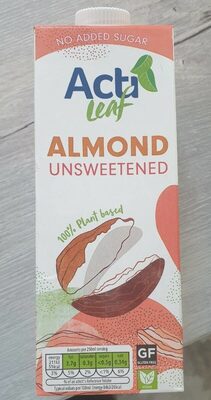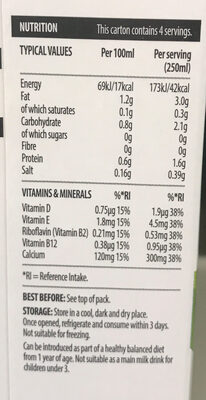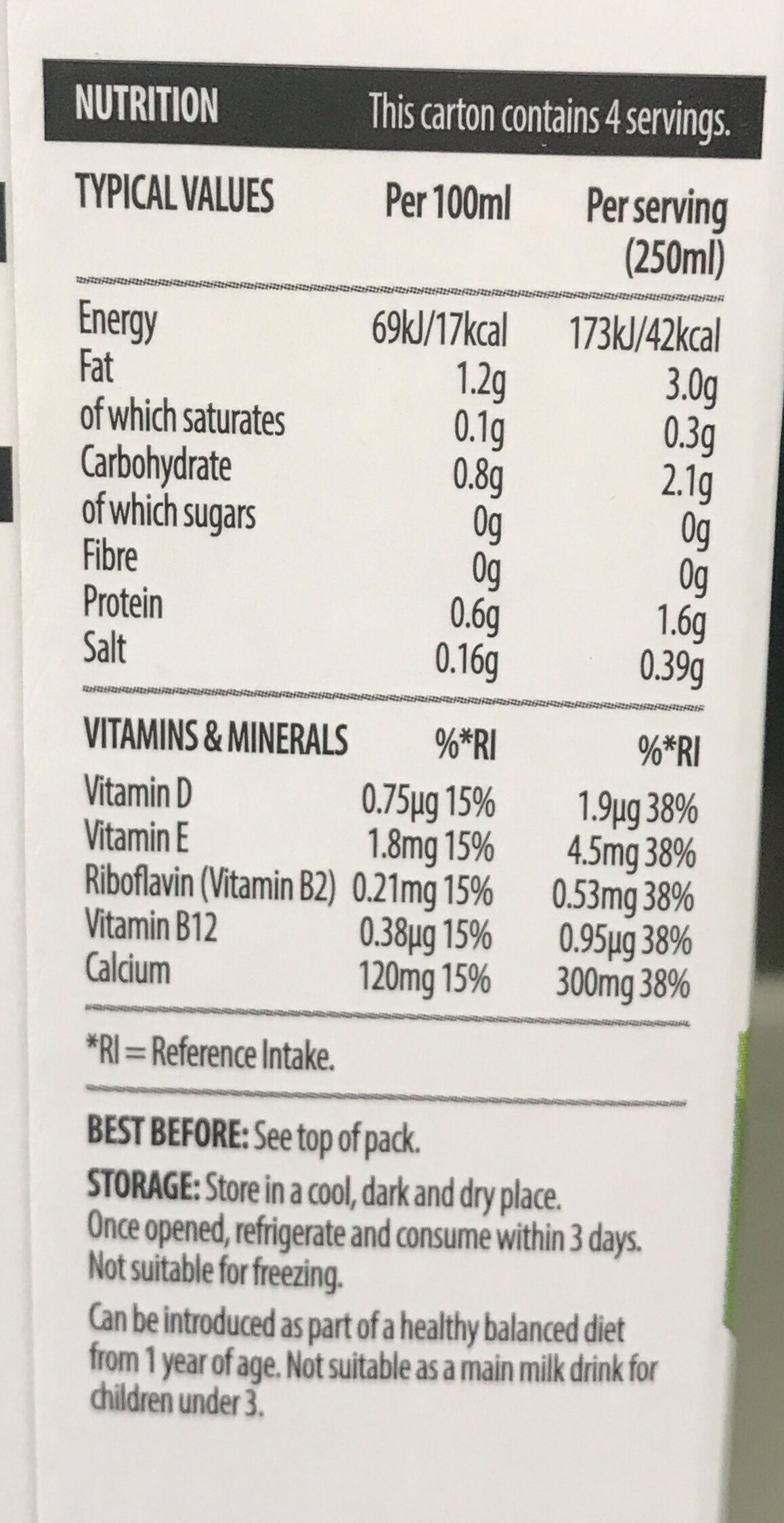Help us make food transparency the norm!
As a non-profit organization, we depend on your donations to continue informing consumers around the world about what they eat.
The food revolution starts with you!
Almond Unsweetened - Acti Leaf - 1l
Almond Unsweetened - Acti Leaf - 1l
This product page is not complete. You can help to complete it by editing it and adding more data from the photos we have, or by taking more photos using the app for Android or iPhone/iPad. Thank you!
×
Barcode: 4088600037745 (EAN / EAN-13)
Quantity: 1l
Packaging: Composite material, Tetra Pak, Composite-carton, Hdpe-cap
Categories: Plant-based foods and beverages, Beverages, Plant-based foods, Dairy substitutes, Milk substitutes, Nuts and their products, Plant-based beverages, Plant-based milk alternatives, Nut-based drinks, Almond-based drinks, Alternative milk
Labels, certifications, awards: No gluten, Vegetarian, Vegan, No added sugar, No lactose
Traceability code: FSC-C014047
Countries where sold: United Kingdom
Matching with your preferences
Health
Ingredients
-
15 ingredients
water, almond (2%), maltodextrin, calcium (calcium phosphates), sea salt, stabilisers: locus bean gum, gellan gum, emulsifier: lecithins (sunflower), riboflavin, vitamin b12, vitamin d2Allergens: Nuts
Food processing
-
Ultra processed foods
Elements that indicate the product is in the 4 - Ultra processed food and drink products group:
- Additive: E101 - Riboflavin
- Additive: E322 - Lecithins
- Additive: E418 - Gellan gum
- Ingredient: Emulsifier
- Ingredient: Maltodextrin
Food products are classified into 4 groups according to their degree of processing:
- Unprocessed or minimally processed foods
- Processed culinary ingredients
- Processed foods
- Ultra processed foods
The determination of the group is based on the category of the product and on the ingredients it contains.
Additives
-
E101 - Riboflavin
Riboflavin: Riboflavin, also known as vitamin B2, is a vitamin found in food and used as a dietary supplement. Food sources include eggs, green vegetables, milk and other dairy product, meat, mushrooms, and almonds. Some countries require its addition to grains. As a supplement it is used to prevent and treat riboflavin deficiency and prevent migraines. It may be given by mouth or injection.It is nearly always well tolerated. Normal doses are safe during pregnancy. Riboflavin is in the vitamin B group. It is required by the body for cellular respiration.Riboflavin was discovered in 1920, isolated in 1933, and first made in 1935. It is on the World Health Organization's List of Essential Medicines, the most effective and safe medicines needed in a health system. Riboflavin is available as a generic medication and over the counter. In the United States a month of supplements costs less than 25 USD.Source: Wikipedia
-
E101i - Riboflavin
Riboflavin: Riboflavin, also known as vitamin B2, is a vitamin found in food and used as a dietary supplement. Food sources include eggs, green vegetables, milk and other dairy product, meat, mushrooms, and almonds. Some countries require its addition to grains. As a supplement it is used to prevent and treat riboflavin deficiency and prevent migraines. It may be given by mouth or injection.It is nearly always well tolerated. Normal doses are safe during pregnancy. Riboflavin is in the vitamin B group. It is required by the body for cellular respiration.Riboflavin was discovered in 1920, isolated in 1933, and first made in 1935. It is on the World Health Organization's List of Essential Medicines, the most effective and safe medicines needed in a health system. Riboflavin is available as a generic medication and over the counter. In the United States a month of supplements costs less than 25 USD.Source: Wikipedia
-
E322 - Lecithins
Lecithins are natural compounds commonly used in the food industry as emulsifiers and stabilizers.
Extracted from sources like soybeans and eggs, lecithins consist of phospholipids that enhance the mixing of oil and water, ensuring smooth textures in various products like chocolates, dressings, and baked goods.
They do not present any known health risks.
-
E418 - Gellan gum
Gellan gum: Gellan gum is a water-soluble anionic polysaccharide produced by the bacterium Sphingomonas elodea -formerly Pseudomonas elodea based on the taxonomic classification at the time of its discovery-. Its taxonomic classification has been subsequently changed to Sphingomonas elodea based on current classification system. The gellan-producing bacterium was discovered and isolated by the former Kelco Division of Merck & Company, Inc. in 1978 from the lily plant tissue from a natural pond in Pennsylvania, USA. It was initially identified as a substitute gelling agent at significantly lower use level to replace agar in solid culture media for the growth of various microorganisms Its initial commercial product with the trademark as "GELRITE" gellan gum, was subsequently identified as a suitable agar substitute as gelling agent in various clinical bacteriological media.Source: Wikipedia
Ingredients analysis
-
Palm oil free
No ingredients containing palm oil detected
Unrecognized ingredients: Locus-bean-gumSome ingredients could not be recognized.
We need your help!
You can help us recognize more ingredients and better analyze the list of ingredients for this product and others:
- Edit this product page to correct spelling mistakes in the ingredients list, and/or to remove ingredients in other languages and sentences that are not related to the ingredients.
- Add new entries, synonyms or translations to our multilingual lists of ingredients, ingredient processing methods, and labels.
If you would like to help, join the #ingredients channel on our Slack discussion space and/or learn about ingredients analysis on our wiki. Thank you!
-
Vegan
No non-vegan ingredients
Unrecognized ingredients: Calcium, Locus-bean-gum, Vitamin b12Some ingredients could not be recognized.
We need your help!
You can help us recognize more ingredients and better analyze the list of ingredients for this product and others:
- Edit this product page to correct spelling mistakes in the ingredients list, and/or to remove ingredients in other languages and sentences that are not related to the ingredients.
- Add new entries, synonyms or translations to our multilingual lists of ingredients, ingredient processing methods, and labels.
If you would like to help, join the #ingredients channel on our Slack discussion space and/or learn about ingredients analysis on our wiki. Thank you!
-
Vegetarian
No non-vegetarian ingredients detected
Unrecognized ingredients: Calcium, Locus-bean-gum, Vitamin b12Some ingredients could not be recognized.
We need your help!
You can help us recognize more ingredients and better analyze the list of ingredients for this product and others:
- Edit this product page to correct spelling mistakes in the ingredients list, and/or to remove ingredients in other languages and sentences that are not related to the ingredients.
- Add new entries, synonyms or translations to our multilingual lists of ingredients, ingredient processing methods, and labels.
If you would like to help, join the #ingredients channel on our Slack discussion space and/or learn about ingredients analysis on our wiki. Thank you!
-
Details of the analysis of the ingredients
We need your help!
Some ingredients could not be recognized.
We need your help!
You can help us recognize more ingredients and better analyze the list of ingredients for this product and others:
- Edit this product page to correct spelling mistakes in the ingredients list, and/or to remove ingredients in other languages and sentences that are not related to the ingredients.
- Add new entries, synonyms or translations to our multilingual lists of ingredients, ingredient processing methods, and labels.
If you would like to help, join the #ingredients channel on our Slack discussion space and/or learn about ingredients analysis on our wiki. Thank you!
: water, almond 2%, maltodextrin, calcium (calcium phosphates), sea salt, stabilisers (locus bean gum), gellan gum, emulsifier (lecithins (sunflower)), riboflavin, vitamin b12, vitamin d2- water -> en:water - vegan: yes - vegetarian: yes - ciqual_food_code: 18066 - percent_min: 93.3 - percent_max: 98
- almond -> en:almond - vegan: yes - vegetarian: yes - ciqual_food_code: 15041 - percent_min: 2 - percent: 2 - percent_max: 2
- maltodextrin -> en:maltodextrin - vegan: yes - vegetarian: yes - percent_min: 0 - percent_max: 2
- calcium -> en:calcium - percent_min: 0 - percent_max: 2
- calcium phosphates -> en:e341 - vegan: yes - vegetarian: yes - percent_min: 0 - percent_max: 2
- sea salt -> en:sea-salt - vegan: yes - vegetarian: yes - ciqual_food_code: 11082 - percent_min: 0 - percent_max: 0.1
- stabilisers -> en:stabiliser - percent_min: 0 - percent_max: 0.1
- locus bean gum -> en:locus-bean-gum - percent_min: 0 - percent_max: 0.1
- gellan gum -> en:e418 - vegan: yes - vegetarian: yes - percent_min: 0 - percent_max: 0.1
- emulsifier -> en:emulsifier - percent_min: 0 - percent_max: 0.1
- lecithins -> en:e322 - vegan: maybe - vegetarian: maybe - percent_min: 0 - percent_max: 0.1
- sunflower -> en:sunflower - vegan: yes - vegetarian: yes - percent_min: 0 - percent_max: 0.1
- lecithins -> en:e322 - vegan: maybe - vegetarian: maybe - percent_min: 0 - percent_max: 0.1
- riboflavin -> en:e101 - vegan: maybe - vegetarian: yes - percent_min: 0 - percent_max: 0.1
- vitamin b12 -> en:vitamin-b12 - percent_min: 0 - percent_max: 0.1
- vitamin d2 -> en:ergocalciferol - vegan: yes - vegetarian: yes - percent_min: 0 - percent_max: 0.1
Nutrition
-
Good nutritional quality
⚠ ️Warning: the amount of fiber is not specified, their possible positive contribution to the grade could not be taken into account.⚠ ️Warning: the amount of fruits, vegetables and nuts is not specified on the label, it was estimated from the list of ingredients: 2This product is not considered a beverage for the calculation of the Nutri-Score.
Positive points: 0
- Proteins: 0 / 5 (value: 0.5, rounded value: 0.5)
- Fiber: 0 / 5 (value: 0, rounded value: 0)
- Fruits, vegetables, nuts, and colza/walnut/olive oils: 0 / 5 (value: 2, rounded value: 2)
Negative points: 0
- Energy: 0 / 10 (value: 84, rounded value: 84)
- Sugars: 0 / 10 (value: 0.5, rounded value: 0.5)
- Saturated fat: 0 / 10 (value: 0.1, rounded value: 0.1)
- Sodium: 0 / 10 (value: 40, rounded value: 40)
The points for proteins are counted because the negative points are less than 11.
Nutritional score: (0 - 0)
Nutri-Score:
-
Nutrient levels
-
Fat in moderate quantity (1.5%)
What you need to know- A high consumption of fat, especially saturated fats, can raise cholesterol, which increases the risk of heart diseases.
Recommendation: Limit the consumption of fat and saturated fat- Choose products with lower fat and saturated fat content.
-
Saturated fat in low quantity (0.1%)
What you need to know- A high consumption of fat, especially saturated fats, can raise cholesterol, which increases the risk of heart diseases.
Recommendation: Limit the consumption of fat and saturated fat- Choose products with lower fat and saturated fat content.
-
Sugars in low quantity (0.5%)
What you need to know- A high consumption of sugar can cause weight gain and tooth decay. It also augments the risk of type 2 diabetes and cardio-vascular diseases.
Recommendation: Limit the consumption of sugar and sugary drinks- Sugary drinks (such as sodas, fruit beverages, and fruit juices and nectars) should be limited as much as possible (no more than 1 glass a day).
- Choose products with lower sugar content and reduce the consumption of products with added sugars.
-
Salt in low quantity (0.1%)
What you need to know- A high consumption of salt (or sodium) can cause raised blood pressure, which can increase the risk of heart disease and stroke.
- Many people who have high blood pressure do not know it, as there are often no symptoms.
- Most people consume too much salt (on average 9 to 12 grams per day), around twice the recommended maximum level of intake.
Recommendation: Limit the consumption of salt and salted food- Reduce the quantity of salt used when cooking, and don't salt again at the table.
- Limit the consumption of salty snacks and choose products with lower salt content.
-
-
Nutrition facts
Nutrition facts As sold
for 100 g / 100 mlCompared to: Almond-based drinks Energy 84 kj
(20 kcal)-38% Fat 1.5 g -16% Saturated fat 0.1 g -40% Carbohydrates 1.3 g -57% Sugars 0.5 g -77% Fiber ? Proteins 0.5 g -32% Salt 0.1 g -15% Fruits‚ vegetables‚ nuts and rapeseed‚ walnut and olive oils (estimate from ingredients list analysis) 2 %
Environment
-
Eco-Score B - Low environmental impact
⚠ ️Select a country in order to include the full impact of transportation.The Eco-Score is an experimental score that summarizes the environmental impacts of food products.→ The Eco-Score was initially developped for France and it is being extended to other European countries. The Eco-Score formula is subject to change as it is regularly improved to make it more precise and better suited to each country.Life cycle analysis
-
Average impact of products of the same category: B (Score: 79/100)
Category: Almond drink not sweet, not fortified, prepacked
Category: Almond drink not sweet, not fortified, prepacked
- PEF environmental score: 0.06 (the lower the score, the lower the impact)
- including impact on climate change: 0.37 kg CO2 eq/kg of product
Stage Impact Agriculture
37.0 %Processing
24.3 %Packaging
16.2 %Transportation
15.6 %Distribution
6.9 %Consumption
0.0 %
Bonuses and maluses
-
Missing origins of ingredients information
Malus: -5
⚠ ️ The origins of the ingredients of this product are not indicated.
If they are indicated on the packaging, you can modify the product sheet and add them.
If you are the manufacturer of this product, you can send us the information with our free platform for producers.
-
Packaging with a medium impact
Malus: -5
Shape Material Recycling Impact Box Paper Low Brick Tetra Pak Medium
Eco-Score for this product
-
Impact for this product: B (Score: 69/100)
Product: Almond Unsweetened - Acti Leaf - 1l
Life cycle analysis score: 79
Sum of bonuses and maluses: -10
Final score: 69/100
-
Carbon footprint
-
Equal to driving 0.2 km in a petrol car
37 g CO² per 100g of product
The carbon emission figure comes from ADEME's Agribalyse database, for the category: Almond drink not sweet, not fortified, prepacked (Source: ADEME Agribalyse Database)
Stage Impact Agriculture
19.2 %Processing
18.5 %Packaging
26.9 %Transportation
31.6 %Distribution
3.9 %Consumption
0.0 %
Packaging
-
Packaging with a medium impact
-
Packaging parts
Box (Paper)
Brick (Tetra Pak)
-
Packaging materials
Material % Packaging weight Packaging weight per 100 g of product Paper or cardboard
-
Transportation
-
Origins of ingredients
Missing origins of ingredients information
⚠ ️ The origins of the ingredients of this product are not indicated.
If they are indicated on the packaging, you can modify the product sheet and add them.
If you are the manufacturer of this product, you can send us the information with our free platform for producers.Add the origins of ingredients for this product Add the origins of ingredients for this product
Report a problem
-
Incomplete or incorrect information?
Category, labels, ingredients, allergens, nutritional information, photos etc.
If the information does not match the information on the packaging, please complete or correct it. Open Food Facts is a collaborative database, and every contribution is useful for all.
Data sources
Product added on by veganeamos
Last edit of product page on by roboto-app.
Product page also edited by andyrodriguez, back-ache, ecoscore-impact-estimator, inf, kiliweb, naruyoko, openfoodfacts-contributors, packbot, sne1991, swipe-studio, teolemon, yuka.UUtZaUtJWUtwdjhueS9JMDNBcm8xTXBJNmJLWVlWS01Ec3NWSWc9PQ, yuka.sY2b0xO6T85zoF3NwEKvllAdYtCCjw-aKDH5wXWUl4reBY61Zu9j5rPHIqg.












